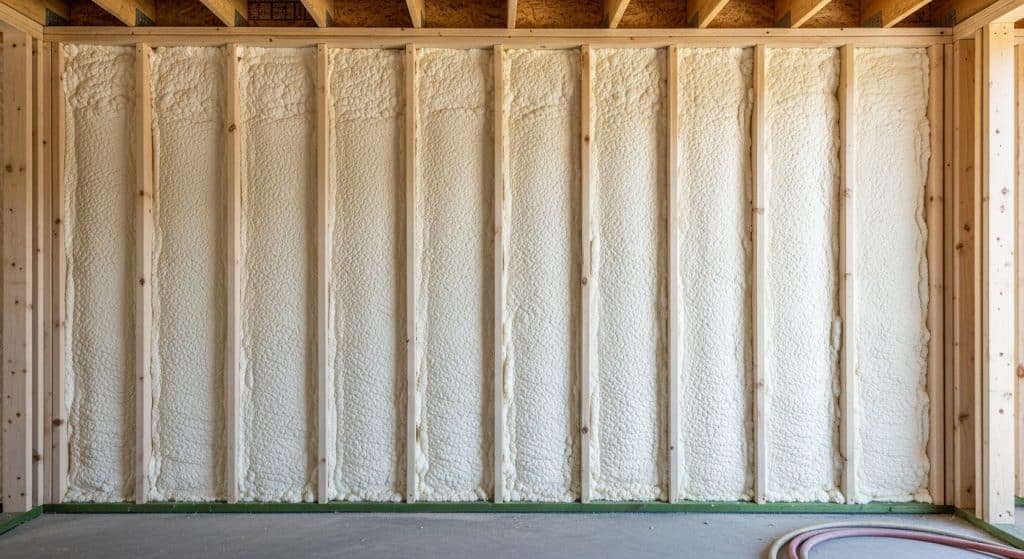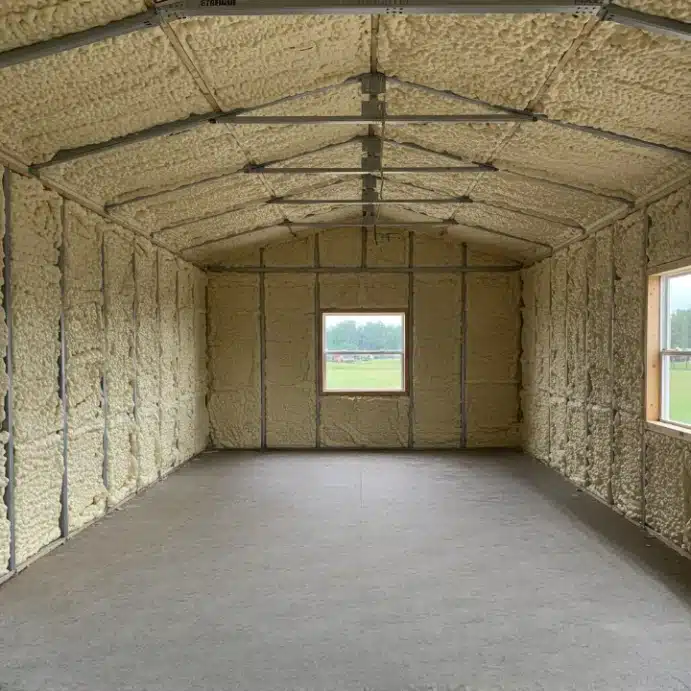Introduction
Imagine standing in a drafty home during a cold winter night, or watching your energy bills climb higher each month despite turning down the thermostat. These everyday frustrations point to a common issue: poor insulation. Spray foam offers a practical solution that seals gaps, blocks air leaks, and boosts energy efficiency in ways traditional materials often can’t match. This guide explores spray foam in depth, from its basic makeup to real-world uses and long-term payback.
Spray foam is a versatile insulation product made from two chemical components that expand when mixed and sprayed onto surfaces. It forms a solid barrier that adheres tightly, creating an airtight seal. Unlike fiberglass batts or cellulose, which can settle or leave voids, spray foam fills cracks and crevices completely. This makes it ideal for homes, commercial buildings, and even agricultural structures in areas like Fresno, where extreme temperatures demand reliable protection.
Why does spray foam matter? It directly tackles rising energy costs and environmental concerns. In California, where summers scorch and winters chill, efficient insulation keeps indoor spaces comfortable without overworking HVAC systems. Homeowners and builders turn to it for its ability to reduce heating and cooling expenses by up to 50%, based on studies from energy experts. Beyond comfort, it adds property value and supports sustainability goals by lowering carbon footprints.
Drawing from years of hands-on work installing and evaluating spray foam systems, this guide offers insights that go beyond surface-level advice. You’ll start with the fundamentals: what spray foam is and how it works. Next, dive into its key benefits and the different types available, including open-cell and closed-cell varieties. Then, examine practical applications across residential, commercial, and specialty settings. Learn the step-by-step installation process, tools needed, and ways to calculate return on investment. Address common hurdles, like moisture issues or professional selection, and look ahead to emerging trends in the field.
By the end, you’ll have a clear understanding of how spray foam delivers value, whether you’re a homeowner planning a retrofit or a contractor seeking reliable options. Use this as your reference to make informed decisions that save money and improve building performance over time.
What Is Spray Foam Insulation?
Spray foam starts as a liquid mixture of polyols and isocyanates. When these chemicals combine at the spray gun’s nozzle, a chemical reaction causes the material to expand rapidly—up to 100 times its liquid volume. This expansion allows it to reach tight spaces that other insulations might miss. Once cured, it hardens into a foam that sticks to wood, concrete, metal, and more.
The process relies on precise temperature and humidity control during application. Too cold, and the foam won’t expand properly; too humid, and it might cure unevenly. Professionals monitor these conditions to ensure consistent results. Spray foam’s R-value, a measure of thermal resistance, typically ranges from 3.5 to 7 per inch, depending on the type—higher than many alternatives like fiberglass (around 2.2 to 4 per inch).
At its foundation, spray foam addresses air infiltration, which accounts for 25-40% of a home’s energy loss, according to the U.S. Department of Energy. By creating a continuous barrier, it prevents conditioned air from escaping and unconditioned air from entering. This not only saves energy but also reduces noise transmission and controls dust and pollen.
How Spray Foam Differs from Other Insulations
Traditional options like batts or blown-in cellulose require framing cavities and can compress over time, creating gaps. Spray foam, applied wet, conforms to irregular shapes without needing additional framing. It also acts as a moisture barrier in some forms, unlike permeable materials that allow vapor through.
For instance, in a rim joist area—a notorious spot for air leaks—spray foam seals around pipes and wiring seamlessly. Data from the Building Science Corporation highlights how this approach cuts air leakage by over 70% compared to standard methods.
Types of Spray Foam: Open-Cell vs. Closed-Cell
Two main categories dominate the market: open-cell and closed-cell spray foam. Each suits different needs based on density, cost, and performance.
Open-cell foam has a lower density (0.5 pounds per cubic foot) and an open structure that traps air. It provides good sound absorption and insulation at R-3.5 per inch. This type allows some vapor permeability, so it breathes with the building. Builders often choose it for interior walls or attics in milder climates.
Closed-cell foam, denser at 2 pounds per cubic foot, features sealed cells that resist moisture and add structural strength. It boasts an R-6 to 7 per inch and serves as a vapor barrier. Ideal for below-grade spaces or exterior walls, it handles wet conditions better. However, it costs more upfront—about 20-30% higher than open-cell.
Here’s a quick comparison:
| Feature | Open-Cell Foam | Closed-Cell Foam |
|---|---|---|
| Density (lb/ft³) | 0.5 | 2.0 |
| R-Value per Inch | 3.5 | 6-7 |
| Moisture Resistance | Moderate (permeable) | High (vapor barrier) |
| Cost per Board Foot | $0.35-$0.50 | $0.65-$1.00 |
| Best For | Interiors, soundproofing | Exteriors, basements |
Market data shows closed-cell foam holds 60% of the U.S. spray foam market share due to its durability, per a report from Grand View Research.
Pros and Cons of Each Type
Open-cell excels in affordability and flexibility but offers less structural support and can absorb water if exposed. Closed-cell provides superior protection against pests and mold but may off-gas slightly during curing, requiring ventilation.
Expert Tip: For homes in humid areas like Fresno, pair open-cell with a vapor retarder to avoid long-term moisture buildup.
[Image: Side-by-side comparison of open-cell (light, spongy) and closed-cell (dense, rigid) spray foam samples]
Key Takeaways:
- Open-cell suits budget-friendly interior projects with decent insulation.
- Closed-cell delivers stronger moisture and structural benefits for demanding environments.
- Choose based on your building’s specific climate and exposure risks.
Key Benefits of Spray Foam Insulation
Spray foam stands out for its multifaceted advantages. Energy savings top the list: a study by the Oak Ridge National Laboratory found that homes with spray foam use 15-20% less energy for heating and cooling than those with conventional insulation.
It also improves indoor air quality by sealing out allergens and pollutants. In commercial settings, this means healthier workspaces and fewer sick days. Additionally, spray foam’s adhesive properties reinforce structures, like roof decks, against wind uplift—critical in storm-prone regions.
Long-term value comes from reduced maintenance. Unlike materials that degrade, spray foam lasts 20-30 years with minimal upkeep. A report from the Spray Polyurethane Foam Alliance notes that it can increase home resale value by 5-10% through verified energy efficiency.
Energy Efficiency and Cost Savings
Consider a typical home in California’s Central Valley: without proper insulation, AC units run constantly in summer, spiking bills. Spray foam cuts these by creating an effective thermal envelope. The U.S. Energy Information Administration reports that residential energy costs average $2,000 annually nationwide, with insulation upgrades paying back in 3-5 years.
Expert Tip: Calculate potential savings using online tools from Energy Star before committing to a project.
Applications of Spray Foam Across Industries
Spray foam’s adaptability makes it useful in various settings. In residential construction, it insulates attics, walls, and crawl spaces to maintain even temperatures.
For commercial buildings, it fills large voids in warehouses or offices, often combined with metal panels. Roof applications, like cathedral ceilings, benefit from its ability to add insulation without losing headspace.
Specialty uses include agricultural barns, where it protects against temperature swings for livestock, or marine vessels for corrosion resistance.
Residential Uses
Homeowners apply it during new builds or retrofits. In rim joists and band boards, it eliminates drafts. For unvented attics, closed-cell foam prevents ice dams in cooler months.
This aligns with the energy savings discussed earlier: a Fresno family retrofitted their 1950s ranch home with spray foam, dropping energy use by 25% and eliminating hot spots.
Commercial and Industrial Applications
Businesses use it for envelope sealing in flat-roofed structures. Data from the North American Insulation Manufacturers Association indicates spray foam roofs last 50 years, far outpacing traditional membranes.
In food processing plants, it maintains hygiene by sealing joints against contaminants.
Expert Tip: For large-scale projects, opt for high-output spray rigs to speed up application without compromising quality.
The Installation Process: Step by Step
Installing spray foam requires preparation and precision. Start with a site assessment: check for moisture, pests, or structural issues. Clean surfaces remove dust and debris to ensure adhesion.
Next, set up protective gear—respirators, suits, and ventilation—since the chemicals are reactive. Use a two-component spray system: one tank for A-component (isocyanate), another for B (polyol).
Apply in layers: spray evenly, letting it cure between passes for thicker builds. Thickness varies—2-3 inches for walls, up to 10 for attics.
Post-installation, trim excess and inspect for uniformity. Professionals certify with thermal imaging to confirm coverage.
Tools and Equipment Needed
Basic kit includes a spray gun, hoses, and proportioner unit. For DIY, smaller kits exist, but full jobs demand certified crews due to safety regs.
| Tool | Purpose | Approximate Cost |
|---|---|---|
| Proportioner Unit | Mixes components precisely | $5,000-$15,000 |
| Spray Gun | Applies foam evenly | $500-$1,000 |
| Protective Gear | Ensures worker safety | $200 per set |
| Thermal Camera | Verifies installation quality | $300-$1,000 |
The International Institute of Building Enclosure Consultants emphasizes training to avoid common errors like over-spraying.
Key Takeaways:
- Proper prep and equipment yield durable results.
- Certified installers handle complexities for best outcomes.
- Verify with inspections to maximize benefits.

Common Challenges and Solutions
One hurdle is uneven application, leading to voids. Solution: use experienced teams who test ambient conditions first.
Moisture during install can cause foaming issues. Mitigate by dehumidifying spaces beforehand.
Cost concerns arise—initial outlay runs $1-2 per square foot. But payback through savings offsets this quickly. A study by Lawrence Berkeley National Laboratory shows ROI in under 7 years for most retrofits.
Off-gassing worries exist, though modern low-VOC formulas minimize this. Ventilate well and follow manufacturer guidelines.
Selecting the Right Professional
Look for contractors with SPFA certification. Ask for references and warranties—typically 20-25 years.
Expert Tip: Request a blower door test pre- and post-install to quantify air sealing improvements.
Measuring Success: ROI and Long-Term Value
Track success with energy audits. Compare utility bills before and after; expect 10-30% reductions.
Structural tests confirm added rigidity, useful in seismic zones like California.
Overall value: spray foam boosts efficiency, comfort, and equity. Market stats from IBISWorld project the insulation industry growing to $20 billion by 2025, driven by foam’s popularity.
Future Trends in Spray Foam Technology
Advancements focus on eco-friendly formulas, like bio-based polyols reducing petroleum use. Bio-sourced foams, per research from the Polyurethane Foam Association, cut emissions by 20%.
Hybrid systems combine spray foam with rigid panels for even better performance.
Smart monitoring integrates sensors to track insulation performance over time.
As building codes tighten for energy use, spray foam will see wider adoption.
Putting Your Spray Foam Strategy into Action
This guide covers spray foam from basics to advanced uses, highlighting its role in energy savings, versatile applications, and solid returns. You’ve seen how different types address specific needs, the install process ensures quality, and overcoming challenges leads to reliable results. Future innovations promise even better options.
Take these steps next: assess your space’s insulation gaps, compare types to your goals, and consult certified experts. Refer back to sections as needed to plan your project confidently.
Need Expert Guidance?
For personalized advice on spray foam options in Fresno, contact Supreme Spray Foam – Fresno at (559) 545-0800 or [email protected]. Their team offers consultations to match solutions to your building needs, ensuring efficient and lasting insulation. Reach out today to discuss your project and start saving on energy costs.
Sources
- U.S. Department of Energy – Government resource on insulation types and energy loss statistics.
- Oak Ridge National Laboratory – Research study on energy efficiency gains from spray foam.
- Grand View Research – Market report on spray foam industry shares and growth.
- Building Science Corporation – Insights on air leakage reduction with spray foam.
- Spray Polyurethane Foam Alliance – Industry association data on longevity and benefits.
- U.S. Energy Information Administration – Statistics on residential energy costs.
- North American Insulation Manufacturers Association – Data on roofing durability.
- Lawrence Berkeley National Laboratory – Study on ROI for insulation upgrades.
- International Institute of Building Enclosure Consultants – Guidelines on installation tools and training.
- IBISWorld – Projections for insulation market growth.
- Polyurethane Foam Association – Information on eco-friendly foam developments.
Frequently Asked Questions About Spray Foam
What is the lifespan of spray foam insulation?
Spray foam lasts 25-80 years, depending on type and conditions. Closed-cell versions endure longer in harsh environments.
Is spray foam safe for homes with allergies?
Yes, once cured, it doesn’t release fibers or particles. It seals out allergens, improving air quality.
Can I install spray foam myself?
Small kits work for minor spots, but full projects need pros due to chemicals and equipment.
Does spray foam work in hot climates like Fresno?
Absolutely—it excels in extreme heat by preventing hot air infiltration and reducing cooling loads.
How much does spray foam cost compared to other insulations?
It costs more upfront ($1-3 per sq ft) but saves long-term through efficiency, unlike cheaper options.
Is spray foam environmentally friendly?
Modern versions use low-GWP blowing agents, supporting green building. It reduces energy use, lowering overall impact.


